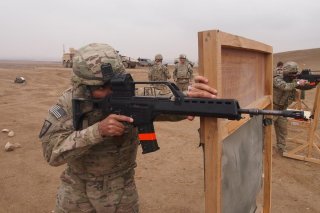Heckler & Koch's Most Powerful Guns of All-Time (RANKED)
One of the most prolific gun sellers in the United States is Germany’s Heckler & Koch.
Key Point: H&K has made everything from pistols to grenade launchers for NATO armies in the wake of World War II.
One of the most prolific gun sellers in the United States is Germany’s Heckler & Koch. The company, started in the wake of World War II by former Mauser engineers Edmund Heckler, Theodor Koch and Alex Seidel, was propelled to worldwide prominence with the adoption of the G3 as the official rifle of the West German Army. Since then, the company has expanded to everything from pistols to grenade launchers, and is a major outfitter of NATO armies—including the U.S. Army and U.S. Marine Corps.
G3 Battle Rifle
The Gewehr-3, or G3, was a battle rifle based on the Spanish CETME, which in turn was based on a wartime German rifle design. Adopted by the West German military in 1959, the G3 uses a delayed blowback operating system. The rifle was made from sheet metal stampings, with plastic handguard, pistol grip, and shoulder stock to help reduce weight. The G3 could fire rifle grenades from the muzzle and a standard magazine held twenty rounds of 7.62mm ammunition. The rifle uses the now-classic Heckler & Koch front post sight protected by a metal circle and range-adjustable rear sights. The G3 had a cyclic rate of fire of 550 rounds per minute. The rifle was was widely exported abroad, with notable clients being Norway, Indonesia, and Saudi Arabia, and to the Third World, particularly Africa.
Recommended: The Colt Python: The Best Revolver Ever Made?
Recommended: Smith & Wesson 500: The Gun That Has As Much Firepower As a Rifle
Recommended: Smith & Wesson's .44 Magnum Revolver: Why You Should Fear the 'Dirty Harry' Gun
VP9 Handgun
Introduced in 2014, the Heckler & Koch VP9 is very much in the mold of the current wave of striker-fired, polymer and steel, high-capacity semi-automatic handguns. The VP uses a polymer frame that contains the metal magazine and fire control group, and the metal slide includes a cold hammer forged barrel. The VP9 is a striker-fired pistol, meaning it uses a striker mechanism instead of a traditional firing pin mechanism to strike the cartridge primer. In a striker-fired pistol, a spring-loaded firing pin is partially cocked by the movement of the slide, with the rest of the cocking taking place when the trigger is pulled. As a result, the VP is safer to carry and has a shorter trigger travel distance, making it quicker to fire.
Like an increasing number of contemporary handguns, the VP has a modular ergonomic system that allows the backstrap and grip panels to be swapped out. The result is a handgun that can be tailored for smaller or larger hands, with a total of twenty-seven possible ergonomic configurations. The VP stores fifteen rounds of 9mm ammunition in a double stack magazine.
MP-5 Submachine Gun
The Heckler & Koch MP-5 (Maschinenpistole-5) was introduced in the 1960s as a scaled-down version of the G3 assault rifle chambered in a pistol caliber. Like the G3, the MP-5 uses the same roller-locked delayed blowback operating system, the same general layout, and the same sights. The MP-5’s main difference is in being significantly shorter, more compact, and lighter, due to its use of the 9mm Parabellum round. The MP-5 was adopted by West German Border Guards in 1966, and later was adopted by the Border Guards’ elite counterterrorism unit, GSG-9. This gradually led to the weapon being adopted by the majority of Western counterterror and special forces units.
416 Assault Rifle
The Heckler & Koch 416 may outwardly bear a strong similarity to the M4 carbine, but internally it’s a different ball game. The M4/M16 rifles use the direct impingement operating system, in which hot gunpowder gases are redirected to cycle the weapon. The 416 instead uses a piston to cycle the weapon. The result is a rifle that runs cooler and requires less cleaning, while being a bit front-heavy. In other respects the 416 is similar to assault rifles in service worldwide, using 5.56mm ammunition in thirty round standard-capacity magazines. The 416 has been adopted by the U.S. Marine Corps, the French army, and an accurized version in 7.62mm has been adopted by the U.S. Army as the Compact Semi-Automatic Sniper System (CSASS).
USP Handgun
The Heckler & Koch Universal Service Pistol (USP) was designed by the company as a response to the meteoric rise of the Glock 17 handgun. Developed in the late 1980s to challenge Glock in the U.S. police market, the USP would later fulfill a requirement with U.S. Special Operations Command for the Offensive Handgun Weapon System program. The SOCOM program resulted in the Mk.23, a .45 caliber variant of the USP with a twelve-round double stack magazine, laser aiming device and suppressor. The weapon is also offered on the civilian market (sans suppressor) chambered in 9mm, .40 Smith & Wesson and .357 Sig. The USP serves as the standard handgun of the German and Spanish armed forces, and is carried by elements of the Danish, Irish, Japanese and South African armed forces.
Kyle Mizokami is a defense and national-security writer based in San Francisco who has appeared in the Diplomat, Foreign Policy, War is Boring and the Daily Beast. In 2009 he cofounded the defense and security blog Japan Security Watch. You can follow him on Twitter: @KyleMizokami.
Image: Pfc. Simeon Taylor, with Bravo Company, 427th Brigade Support Battalion, fires the German made Heckler & Koch G36 assault rifle during the qualification for the schützenschnur badge, at the German marksmanship range, on Nov. 17 in Mazare-e Sharif, Afghanistan. U.S. Army/Spc. Isaac Adams.

